Top 10 best cuisines in the world 2022 based on popularity, diversity, and cultural significance. Food is not only a source of nourishment but also a reflection of culture and heritage. Each country has its own unique cuisine, with distinct flavors, ingredients, and cooking techniques. Whether you’re a foodie or simply appreciate good food, exploring the culinary traditions of different cultures can be an enriching and delicious experience. In this article, we will take a look at the top 10 best cuisines in the world, based on popularity, diversity, and cultural significance. From Italian pasta to Indian curry to Japanese sushi, these cuisines offer a tantalizing array of flavors and dishes that will make your taste buds dance with delight. Join us on a gastronomic journey around the world, as we discover the most mouth-watering and iconic cuisines that define the essence of each country.
The top 10 best cuisines in the world in 2022 are:
- Italian cuisine: famous for its pasta, pizza, seafood, and gelato.
- Chinese cuisine: a diverse cuisine with a wide range of flavors and ingredients, including rice, noodles, seafood, and vegetables.
- French cuisine: known for its sophisticated and refined dishes, such as escargots, bouillabaisse, and crème brûlée.
- Indian cuisine: a colorful and aromatic cuisine with a variety of spices, herbs, and flavors.
- Japanese cuisine: famous for sushi, ramen, tempura, and other delicacies.
- Spanish cuisine: known for its paella, tapas, and seafood dishes.
- Mexican cuisine: a fusion of indigenous and Spanish influences, famous for its tacos, guacamole, and salsa.
- Thai cuisine: a combination of sweet, sour, spicy, and salty flavors, famous for its curries, stir-fries, and street food.
- Middle Eastern cuisine: a diverse cuisine with a variety of dishes, including falafel, shawarma, hummus, and kebabs.
- Korean cuisine: is known for its spicy and flavorful dishes, such as kimchi, bibimbap, and bulgogi.
Table of Contents
Now Let’s Talk about the 10 top cuisines in detail.
1. Italian cuisine:

Italian cuisine is one of the most popular and beloved cuisines in the world. It is characterized by its simplicity, fresh ingredients, and hearty flavors. From pasta and pizza to gelato and espresso, Italian food has become synonymous with comfort, warmth, and hospitality.
One of the hallmarks of Italian cuisine is its emphasis on fresh, seasonal ingredients. Italians believe in using the freshest produce, meats, and dairy products to create simple yet flavorful dishes. Olive oil, tomatoes, cheese, and wine are some of the key ingredients that are used in many Italian dishes.
Pasta is one of the most iconic Italian foods, with over 600 different types of pasta shapes available. From spaghetti to lasagna to ravioli, there is a pasta dish for every occasion. Italian cuisine is also known for its pizza, which originated in Naples in the 18th century. The classic Margherita pizza, topped with tomato sauce, mozzarella cheese, and fresh basil, is still one of the most popular pizza toppings today.
Italian desserts are equally famous, with gelato, tiramisu, and panna cotta being some of the most popular sweet treats. Italians also love their coffee, with espresso being a staple of daily life.
Italian cuisine has had a significant impact on food culture around the world, with Italian restaurants and dishes being found in every corner of the globe. Italian cuisine has also inspired many chefs and home cooks to experiment with new flavors and techniques.
In conclusion, Italian cuisine is a celebration of fresh ingredients, simple flavors, and hearty dishes. From pasta to pizza to gelato, Italian food is a testament to the warmth and hospitality of Italian culture. Whether you’re in Italy or enjoying Italian cuisine from afar, it’s hard not to fall in love with the flavors and traditions of this beloved cuisine.
2. Chinese cuisine:

Chinese cuisine is one of the oldest and most diverse culinary traditions in the world. With over 5000 years of history, Chinese food is characterized by its bold flavors, use of spices and herbs, and emphasis on freshness. Chinese cuisine is also known for its health benefits, with many dishes incorporating nutritious ingredients like vegetables, tofu, and seafood.
One of the most iconic aspects of Chinese cuisine is its use of spices and herbs. From Sichuan peppercorns to ginger to garlic, Chinese cuisine is renowned for its complex and bold flavors. Many dishes also incorporate a variety of sauces, including soy sauce, hoisin sauce, and oyster sauce, to add depth and richness to the flavors.
Another hallmark of Chinese cuisine is its emphasis on fresh ingredients. Chinese chefs believe in using the freshest produce, meats, and seafood to create flavorful and nutritious dishes. Some of the most popular ingredients in Chinese cuisine include bok choy, Chinese cabbage, mushrooms, bamboo shoots, and tofu.
Chinese cuisine is also famous for its variety of cooking techniques, including stir-frying, steaming, boiling, and braising. These techniques help to preserve the natural flavors and textures of the ingredients, while also creating unique and delicious dishes.
Some of the most popular Chinese dishes include dumplings, noodles, stir-fries, and seafood. Many Chinese dishes are also served family-style, with several dishes shared among the diners. This communal style of dining is a testament to the importance of family and community in Chinese culture.
In conclusion, Chinese cuisine is a celebration of bold flavors, fresh ingredients, and healthful cooking techniques. From dumplings to stir-fries to seafood, Chinese food has become a beloved part of the culinary culture around the world. Whether you’re enjoying a classic dish like kung pao chicken or discovering a new flavor combination, Chinese cuisine is sure to delight and inspire.
3. French cuisine:

French cuisine is known worldwide for its elegance, sophistication, and attention to detail. French food is a celebration of the freshest ingredients, classic cooking techniques, and a deep respect for tradition. French cuisine is also famous for its wide range of flavors and textures, as well as its emphasis on wine and cheese.
One of the most iconic aspects of French cuisine is its use of sauces. From hollandaise to béchamel to velouté, French chefs are renowned for their mastery of sauces. These sauces are often used to complement and enhance the flavors of meats, seafood, and vegetables.
Another hallmark of French cuisine is its emphasis on regional ingredients. From the butter of Normandy to the truffles of Perigord to the wines of Bordeaux, French cuisine is a celebration of the unique flavors and traditions of different regions throughout France.
French cuisine is also famous for its breads and pastries. Croissants, baguettes, and brioche are staples of French breakfasts, while pastries like éclairs, tarts, and macarons are beloved desserts.
French cuisine is also known for its emphasis on presentation. French chefs believe that food should not only taste good, but also look beautiful. French dishes are often meticulously arranged on the plate to create a feast for the eyes as well as the palate.
In conclusion, French cuisine is a celebration of the finest ingredients, classic cooking techniques, and a deep respect for tradition. From sauces to regional specialties to pastries, French food is a testament to the elegance and sophistication of French culture. Whether you’re enjoying a classic dish like coq au vin or indulging in a sweet treat like a macaron, French cuisine is sure to delight and inspire.
4. Indian cuisine:

Indian cuisine is known for its bold flavors, rich spices, and varied regional specialties. From street food to fine dining, Indian food is a celebration of diverse cultural influences, fresh ingredients, and a deep appreciation for culinary tradition.
One of the most iconic aspects of Indian cuisine is its use of spices. From cumin to coriander to turmeric, Indian food is famous for its complex and richly layered flavors. Spices are often used to create fragrant spice blends, such as garam masala or curry powder, that are used to add depth and richness to many dishes.
Indian cuisine is also known for its vegetarian and vegan options. With a strong tradition of vegetarianism in many regions, Indian cuisine incorporates a variety of fresh and nutritious ingredients like lentils, chickpeas, vegetables, and paneer (a type of Indian cheese).
Another hallmark of Indian cuisine is its regional specialties. From the biryanis of Hyderabad to the chaats of Mumbai to the dosas of Chennai, each region of India has its own unique culinary traditions and specialties. These regional dishes reflect the local ingredients, flavors, and cultural influences that make Indian cuisine so diverse and vibrant.
Indian food is often served family-style, with several dishes shared among the diners. This communal style of dining is a testament to the importance of family and community in Indian culture.
In conclusion, Indian cuisine is a celebration of bold flavors, varied regional specialties, and a deep appreciation for culinary tradition. From spices to vegetarian options to regional specialties, Indian food is a feast for the senses that reflects the diverse cultural influences and culinary traditions of this vibrant and colorful country. Whether you’re enjoying a classic dish like butter chicken or discovering a new flavor combination, Indian cuisine is sure to delight and inspire.
5. Japanese cuisine:

Japanese cuisine is known for its clean flavors, fresh ingredients, and attention to detail. From sushi to ramen to bento boxes, Japanese food is a celebration of the natural flavors of the ingredients and a deep respect for culinary tradition.
One of the most iconic aspects of Japanese cuisine is its use of fish and seafood. With a long history of fishing and a reverence for the sea, Japanese cuisine is known for its expertly prepared and beautifully presented raw fish dishes like sushi and sashimi.
Japanese cuisine is also famous for its emphasis on umami, the fifth taste sensation after sweet, sour, salty, and bitter. Umami is often achieved through the use of ingredients like soy sauce, miso, and bonito flakes, which are used to add depth and richness to many Japanese dishes.
Another hallmark of Japanese cuisine is its attention to presentation. Japanese chefs believe that food should not only taste good, but also look beautiful. Dishes are often carefully arranged on the plate to create a balance of colors, textures, and flavors.
Japanese cuisine also has a strong emphasis on seasonality. With a focus on fresh, local ingredients, Japanese dishes change with the seasons to take advantage of the best produce available.
In conclusion, Japanese cuisine is a celebration of clean flavors, fresh ingredients, and attention to detail. From fish and seafood to umami to beautiful presentation, Japanese food is a testament to the precision and craftsmanship of Japanese culture. Whether you’re enjoying a classic dish like tempura or discovering a new flavor combination in a bento box, Japanese cuisine is sure to delight and inspire.
Also Read 15 Landmarks To Visit Before You Turn 65
6. Spanish Cuisine
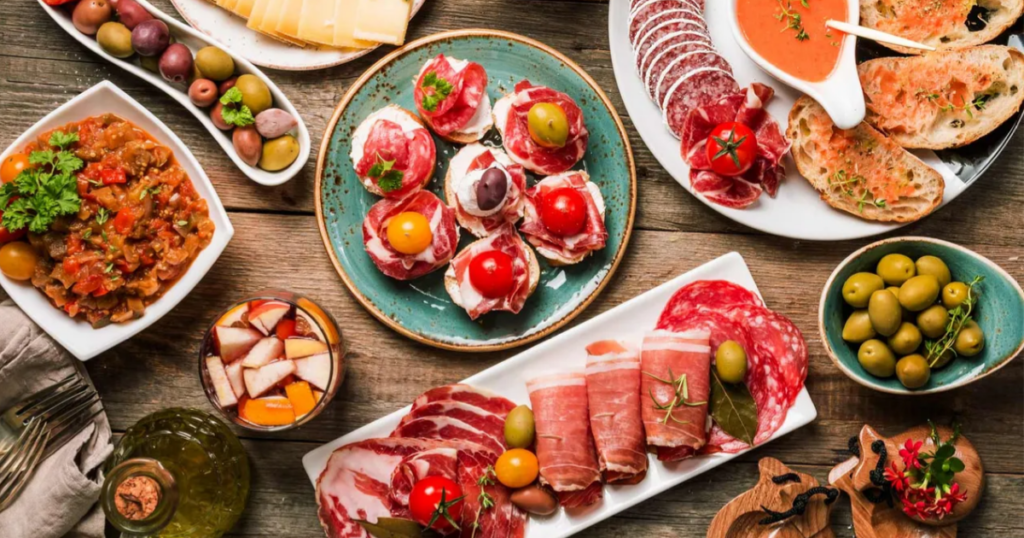
Spanish cuisine, also known as cocina española, is a diverse and flavorful cuisine that has been influenced by a variety of cultural and historical factors. Spanning across different regions of Spain, the cuisine is characterized by its use of fresh ingredients, bold flavors, and unique cooking techniques. With its rich culinary history, Spanish cuisine is a popular cuisine that is loved by people all around the world.
One of the most iconic aspects of Spanish cuisine is tapas. These small plates of food are a staple of Spanish cuisine and are often enjoyed as a light meal or snack. Some of the most popular tapas dishes include patatas bravas, fried potatoes served with a spicy tomato sauce, and croquetas, crispy fried balls filled with ingredients such as ham, cheese, or mushrooms.
Another hallmark of Spanish cuisine is paella, a rice dish that originated in Valencia. Traditionally made with saffron, rice, and a variety of seafood, paella is now made with different meats and vegetables depending on the region of Spain. Paella is often served as a communal dish, with friends and family gathering around a large paella pan to share the meal.
Spanish cuisine is also known for its use of fresh ingredients, particularly seafood. With its location along the Mediterranean Sea, Spain has a rich seafood culture, and dishes such as pulpo a la gallega, octopus with paprika, and gambas al ajillo, garlic shrimp, are popular dishes that showcase the country’s love of seafood.
One of the most famous Spanish ingredients is jamón, or cured ham. Spain is known for its variety of cured hams, including Jamón Ibérico, made from black Iberian pigs that roam free in the countryside. These hams are often sliced thin and served as a tapa or used as an ingredient in dishes such as tortilla española, a potato and egg omelet.
Spanish cuisine also has a rich tradition of soups and stews. One of the most popular is gazpacho, a cold soup made with tomatoes, cucumbers, peppers, and bread. Another popular soup is cocido, a hearty stew made with chickpeas, vegetables, and meat.
Wine is an important part of Spanish cuisine, with Spain being one of the largest wine producers in the world. Some of the most popular Spanish wines include Rioja, Tempranillo, and Albariño. Wine is often paired with food, and many Spanish dishes are cooked with wine, such as pollo al vino, chicken cooked in white wine.
Spanish cuisine is heavily influenced by the country’s history and culture. The Moors, who ruled Spain for over 700 years, introduced ingredients such as almonds, citrus fruits, and spices, which have become a part of the country’s cuisine. The influence of the New World can also be seen in Spanish cuisine, with ingredients such as tomatoes, potatoes, and peppers being introduced to Spain from the Americas.
Regional differences in Spanish cuisine are also significant, with each region having its own unique specialties. The cuisine of Catalonia, for example, is known for its use of seafood and rice dishes, while the cuisine of Andalusia is known for its use of olives and spices.
One of the most famous culinary events in Spain is La Tomatina, a festival held in the town of Buñol in which participants throw tomatoes at each other. Another popular festival is San Fermin, which is held in Pamplona and features the famous Running of the Bulls.
In conclusion, Spanish cuisine is a diverse and flavorful cuisine that has been influenced by a variety of cultural and historical factors. With its use of fresh ingredients, bold flavors, and unique cooking techniques, Spanish cuisine has become a beloved cuisine that is enjoyed by people all around
7. Mexican Cuisine
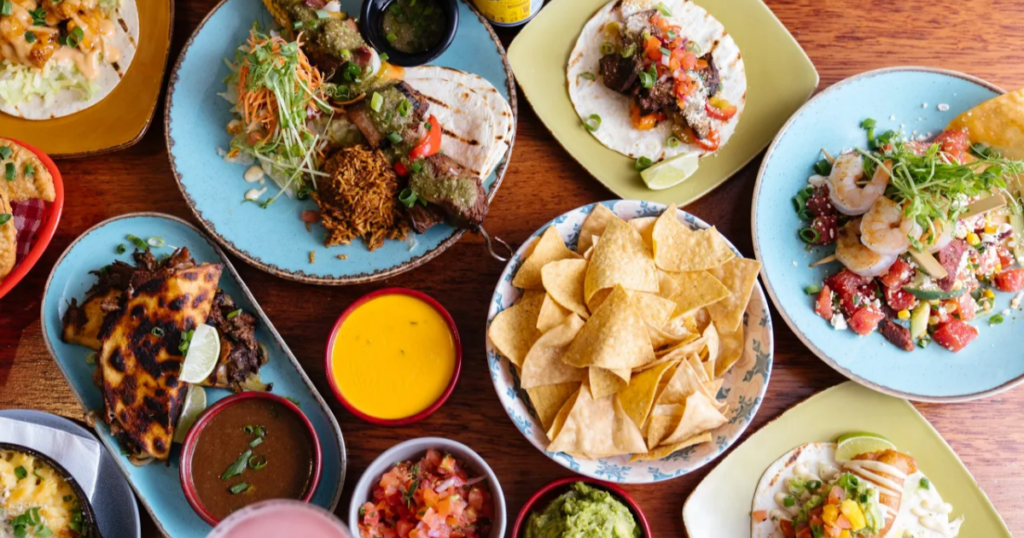
Mexican cuisine is one of the most diverse and flavorful cuisines in the world, with a rich history that dates back thousands of years. From street tacos and guacamole to mole and tamales, Mexican food has something for everyone.
Mexican cuisine is known for its bold and vibrant flavors, which are a result of the country’s unique blend of indigenous, European, and African culinary traditions. The cuisine is also characterized by its use of fresh ingredients, such as chili peppers, tomatoes, and cilantro, as well as spices like cumin, oregano, and cinnamon.
One of the most popular dishes in Mexican cuisine is the taco. Tacos are a traditional Mexican street food that is made by filling a small, soft tortilla with meat, vegetables, and toppings. Some of the most popular taco fillings include carne asada (grilled beef), al pastor (marinated pork), and pollo (chicken). Tacos are often served with a variety of toppings, such as salsa, guacamole, and sour cream.
Another popular dish in Mexican cuisine is guacamole. Guacamole is a dip made from mashed avocados, onion, tomato, and lime juice. It is often served with tortilla chips or as a topping for tacos and other dishes.
Mole is another classic Mexican dish that is known for its complex and rich flavor. Mole is a sauce made from a variety of ingredients, including chili peppers, nuts, seeds, and spices. There are many different types of mole, with the most popular being mole poblano, which is made with chocolate and served with chicken.
Tamales are a traditional Mexican dish that is made by filling a corn husk with masa (a dough made from cornmeal) and a filling, such as pork or chicken. Tamales are then steamed until cooked through and served with salsa or other toppings.
Mexican cuisine is also known for its delicious desserts, such as churros and tres leches cake. Churros are a fried dough pastry that is often rolled in cinnamon sugar and served with chocolate sauce. Tres leches cake is a sponge cake that is soaked in a mixture of three different milks (evaporated milk, condensed milk, and heavy cream) and topped with whipped cream.
In addition to its delicious food, Mexican cuisine also has a rich history and culture. Mexican cuisine is heavily influenced by the country’s indigenous populations, as well as by Spanish colonizers who introduced new ingredients and cooking techniques. Mexican cuisine also incorporates elements of African cuisine, which were brought to Mexico by enslaved Africans during the colonial period.
Overall, Mexican cuisine is a diverse and flavorful cuisine that is beloved around the world. Whether you’re a fan of spicy street tacos or rich and complex mole sauce, there is something in Mexican cuisine for everyone to enjoy.
8. Thai Cuisine
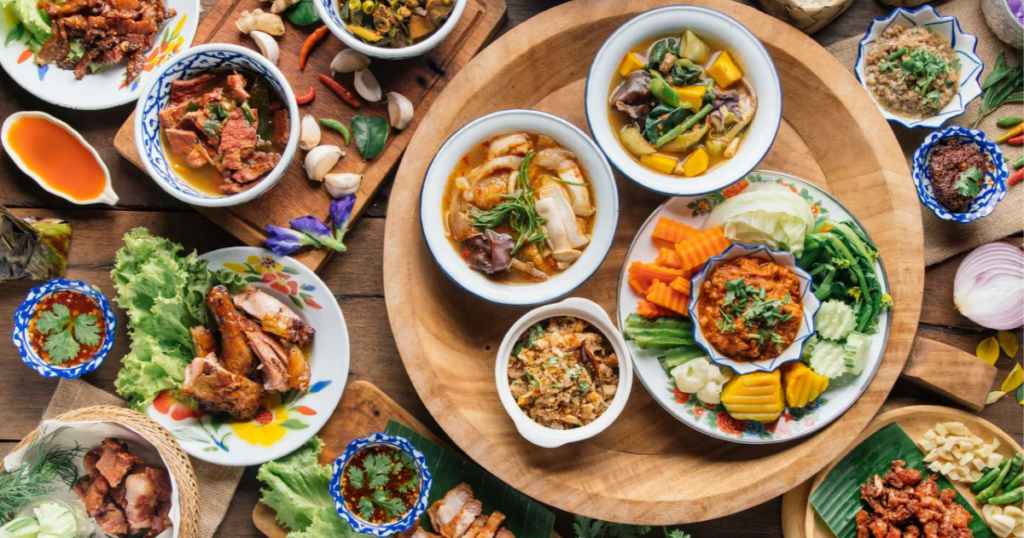
Thai cuisine is a delicious and unique culinary experience that is beloved by people all over the world. Known for its bold flavors, fresh ingredients, and beautiful presentation, Thai food is a feast for the senses that never fails to delight.
At the heart of Thai cuisine is a deep respect for the natural world and the bounty that it provides. Many Thai dishes feature fresh herbs and spices, such as lemongrass, coriander, and ginger, as well as fragrant fruits and vegetables like mango, papaya, and coconut. Seafood is also a popular component of many Thai dishes, as Thailand boasts an abundance of fish and shellfish that are caught in the surrounding waters.
One of the hallmarks of Thai cuisine is its emphasis on balance and harmony. Thai chefs strive to create dishes that balance sour, sweet, salty, and spicy flavors in perfect proportion. The result is a cuisine that is at once complex and nuanced, with each ingredient contributing to a greater whole.
One of the most famous Thai dishes is, of course, Pad Thai. This stir-fried noodle dish is made with rice noodles, tofu, bean sprouts, and a sweet and sour sauce made with tamarind, fish sauce, and palm sugar. It is typically served with a sprinkle of peanuts and a wedge of lime, and can be customized with additional ingredients such as shrimp, chicken, or pork.
Another beloved Thai dish is Tom Yum soup. This spicy and sour soup is typically made with shrimp, lemongrass, lime leaves, galangal, and chili peppers, and is known for its distinctive, citrusy flavor. It is often served as a starter to a larger meal, and is a favorite among Thai people and visitors alike.
Curries are also an important part of Thai cuisine, with many different types of curries available to choose from. Green curry, made with green chilies, coconut milk, and fish sauce, is a popular choice, as is Massaman curry, which is made with peanuts, potatoes, and cinnamon. Thai curries are typically served with rice or noodles and can be made with a variety of different proteins, including chicken, beef, or tofu.
Overall, Thai cuisine is a vibrant and flavorful culinary tradition that continues to captivate diners around the world. Whether you are a fan of spicy and sour soups or sweet and savory stir-fries, there is sure to be a Thai dish that will tantalize your taste buds and leave you feeling satisfied and nourished.
9. Middle Eastern Cuisine
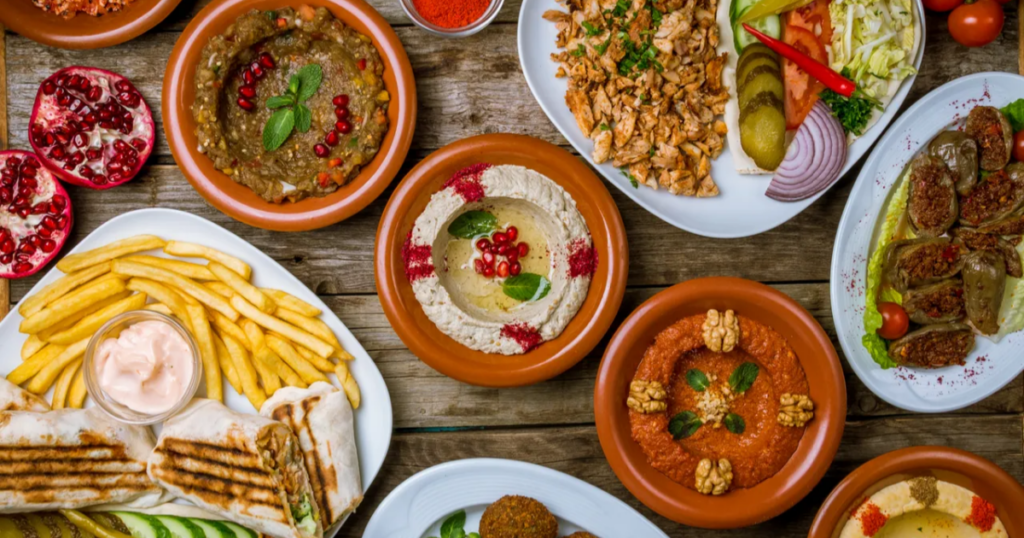
Middle Eastern cuisine is a rich and diverse blend of flavors, spices, and textures that has evolved over thousands of years. It encompasses a wide variety of dishes, from savory and spicy to sweet and tangy. This cuisine is known for its generous use of herbs and spices, including cinnamon, cardamom, cumin, coriander, sumac, and za’atar. Middle Eastern cuisine also includes a range of vegetarian and meat-based dishes, along with a variety of breads, sweets, and beverages.
The Middle East is a vast region that spans from the eastern Mediterranean to the Arabian Peninsula, and from North Africa to Central Asia. As a result, there is no single cuisine that can be considered representative of the entire region. However, there are some common themes that tie the various cuisines together. , such as rice, bulgur, and couscous, as well as legumes like lentils and chickpeas.
Another common theme in Middle Eastern cuisine is the use of meat and poultry, particularly lamb, beef, and chicken. These meats are often prepared using a variety of cooking techniques, such as grilling, roasting, and stewing. One of the most popular meat dishes in the region is kebab, which consists of skewered meat that is grilled over an open flame. Shawarma, which is similar to a gyro, is another popular meat dish that is made from thinly sliced meat that is roasted on a vertical spit.
Vegetables are also an important part of Middle Eastern cuisine, and they are often used in stews, soups, and salads. Some of the most commonly used vegetables in the region include eggplant, okra, tomatoes, cucumbers, onions, and garlic. One of the most popular vegetable dishes in the region is baba ghanoush, which is made from roasted eggplant that is mashed and mixed with tahini, garlic, and lemon juice.
Middle Eastern cuisine is also known for its wide variety of breads. Some of the most popular breads in the region include pita, naan, and lavash. These breads are often served with a variety of dips and spreads, such as hummus, baba ghanoush, and labneh. In addition, Middle Eastern cuisine includes a variety of sweets and desserts, such as baklava, halva, and Turkish delight.
Beverages are also an important part of Middle Eastern cuisine, and the region is known for its rich coffee and tea cultures. One of the most popular beverages in the region is Turkish coffee, which is a strong and rich coffee that is traditionally served in small cups. Mint tea is another popular beverage in the region, and it is often served with sugar and fresh mint leaves.
In conclusion, Middle Eastern cuisine is a rich and diverse culinary tradition that reflects the region’s long and storied history. It is characterized by its use of grains, legumes, meat, and vegetables, as well as its generous use of herbs and spices. Middle Eastern cuisine includes a wide variety of dishes, from savory and spicy to sweet and tangy, and it is sure to please even the most discerning of palates. Whether you are looking for a hearty meal or a sweet treat, Middle Eastern cuisine has something for everyone.
Also Read 15 Landmarks To Visit Before You Turn 65
10. Korean Cuisine
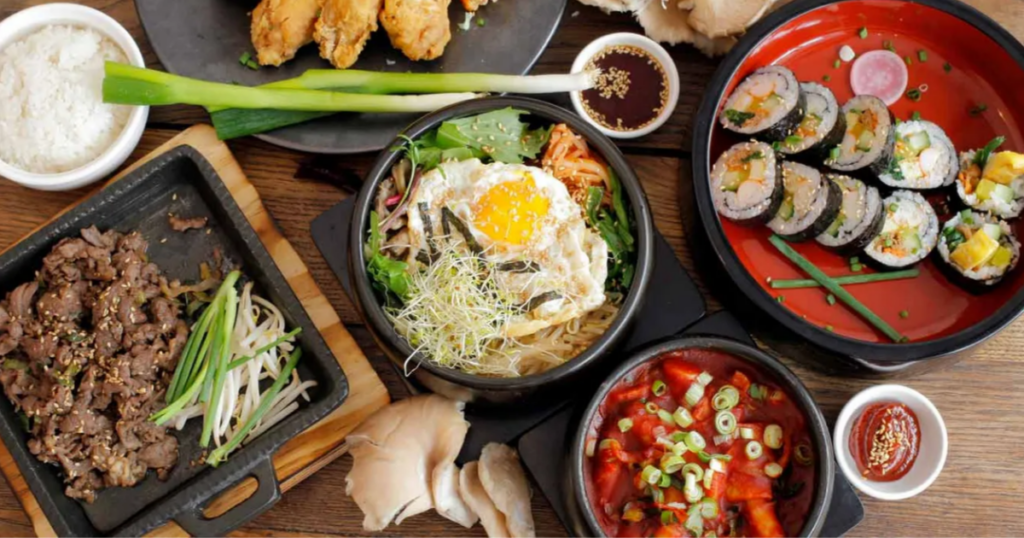
Korean cuisine, also known as Hansik, is a unique and flavorful cuisine that has been gaining popularity worldwide in recent years. It is a cuisine that has a long history and has been shaped by Korea’s geography, climate, and cultural traditions. Korean cuisine is characterized by its use of a wide variety of ingredients, such as rice, vegetables, meats, seafood, and spices, which are combined in a way that creates a balance of flavors and textures.
Korean cuisine has a long and complex history that is tied to the country’s geography, climate, and cultural traditions. The cuisine’s origins can be traced back to the prehistoric era, when Koreans began to cultivate rice and other crops. Over time, as Korea became more urbanized and its culture more sophisticated, the cuisine evolved into what it is today.
One of the most important aspects of Korean cuisine is its emphasis on health and balance. Korean food is often described as being rich in nutrients and low in fat, with a focus on fresh vegetables, lean meats, and seafood. Many Korean dishes are also fermented, which not only adds flavor but also promotes gut health.
Another hallmark of Korean cuisine is its use of spicy flavors. Many dishes are made with gochujang, a spicy red pepper paste, or gochugaru, a dried red pepper powder. Spicy foods are believed to have a warming effect on the body and are thought to be good for digestion.
Korean cuisine is also notable for its use of seasonings and sauces. Soy sauce, sesame oil, garlic, ginger, and scallions are all common ingredients in Korean cooking. These seasonings are often combined in various ways to create different flavor profiles, such as the sweet and savory taste of bulgogi, a marinated beef dish, or the sour and spicy flavor of kimchi, a fermented vegetable dish.
One of the most iconic Korean dishes is kimchi, a spicy fermented vegetable dish that is made with cabbage, radish, or cucumber. Kimchi is an essential part of Korean cuisine and is served with almost every meal. It is believed to have originated in the 7th century, when Koreans began to ferment vegetables in order to preserve them for the winter months. Today, there are many different varieties of kimchi, each with its own unique flavor and texture.
Another popular Korean dish is bibimbap, a rice dish that is served with a variety of vegetables, meats, and a fried egg. The ingredients are mixed together with gochujang sauce and eaten with a spoon. Bibimbap is a popular comfort food in Korea and is often served at home or in restaurants.
Korean barbecue, or gogi-gui, is another popular cuisine. This is a method of grilling meat, usually beef, pork, or chicken, at the table. The meat is typically marinated in a sweet and savory sauce and is cooked over a charcoal grill. The grilled meat is often served with rice, kimchi, and other side dishes.
Korean cuisine also has a rich tradition of soups and stews. One of the most popular is doenjang jjigae, a soybean paste stew that is made with tofu, vegetables, and seafood or meat. Another popular soup is samgyetang, a chicken soup that is made with ginseng, garlic, and jujubes. These soups are often served as a main course and are believed to have health benefits.
Korean cuisine has also been influenced by its neighbors, including China and Japan. One example is jajangmyeon, a noodle dish that is made with a black bean sauce and is believed to have originated in China. Another example is katsu, a breaded and fried pork cutlet that is similar to the Japanese tonkatsu.
Despite these influences, Korean cuisine has maintained its unique identity and has continued to evolve over time. In recent years, Korean food has become increasingly popular around the world, with Korean restaurants popping up in major cities and Korean ingredients and flavors appearing in recipes and products.
One reason for the popularity of Korean cuisine is its emphasis on health and wellness. Korean food is known for being low in fat and high in nutrients, with a focus on fresh ingredients and balanced flavors. Korean cuisine is also often fermented, which is believed to have numerous health benefits, such as improving digestion and boosting the immune system.
Another reason for the popularity of Korean cuisine is its diversity and complexity. Korean food is made up of a wide range of ingredients and flavors, with different regions of the country having their own unique specialties. Korean food is also often presented in a visually stunning way, with colorful and artfully arranged dishes.
Korean cuisine is also steeped in tradition and culture. Many dishes have a long history and are tied to specific occasions or events. For example, tteokguk, a rice cake soup, is traditionally eaten on New Year’s Day and is believed to bring good luck and longevity.
Korean cuisine is also tied to social and family traditions. In Korea, food is often shared and eaten communally, with dishes placed in the center of the table for everyone to share. Family gatherings and holidays are often centered around food, with elaborate feasts prepared and shared among loved ones.
Despite its popularity and growing influence, Korean cuisine is still relatively unknown to many people outside of Korea. However, with its unique flavors, health benefits, and rich cultural history, it is likely that Korean cuisine will continue to gain in popularity and influence in the years to come.
Comment Down and tell us about your favorite Cuisines. Also let us know if you want us to write about some other types of Cuisines.
Follow us on Youtube

